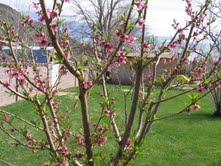
SOUTHERN UTAH – Spring is about here! And your fruit trees are begging for attention. Fruit trees require very little care, produce heavily, and are already starting to bloom in some areas. Apricots are the early bird, but peaches, pears and apples are not far behind.
Dormant Oil
Fruit trees should be sprayed with dormant oil prior to blooming. Dormant oil is inexpensive, nontoxic and prevents a lot of bugs and worms in the wood and in the fruit. A small hand pump sprayer can apply dormant oil. Just walk around the tree and spray until all the wood is wet. For large trees, a spray adapter that will work from the end of your garden hose can be used, allowing you to reach the top of larger trees. Dormant oil should not be applied after trees begin to bloom.
Pruning
Fruit trees can be pruned throughout the winter and early spring. It’s not too late to prune now if you haven’t already pruned. Pruning has three functions: tree health, shaping, and fruit production. A fruit tree needs to be balanced, open so sunlight can reach the entire tree, and pruned so new growth will bloom and bear fruit the following year. By and large, fruit trees bear fruit on two-year-old wood or older, so don’t prune back too far or you may not get any fruit until the next year. Again, any dead wood should be removed; crossed branches, rubbing branches, and parallel branches should all be eliminated. Utah State University Extension’s publication, “Pruning the Orchard”, will provide you more detail.
Fertilizer
Fruit trees need a lot of phosphate to produce all the fruit they are capable of producing. Mono-ammonium phosphate is about 10-50-0, meaning it has 10 percent nitrogen and 50 percent phosphate. This fertilizer is water soluble, and can be sprayed, dripped or watered in around the trees. One treatment in early spring and another after fruit is about golf ball-size is usually adequate.
If mono-ammonium phosphate is not available, any 12-12-12 or similar makeup will do, but the phosphate in these fertilizers is not water-soluble and doesn’t assimilate well into the tree.
Varieties
If you plant a tomato variety you don’t like, you can always choose something different next year, but with fruit trees, you are pretty much stuck with whatever you plant because it’s going to be there for a long time. There are many varieties to choose from, so plant what you like. If you are unsure, talk to your neighbors, old-timers, nurserymen, and research on the Internet or elsewhere before making your decision.
Apricot: Chinese apricots are a good variety for Southern Utah; they yield large fruit, good taste, and do well in our climate. I’ve not cared for Tiltons, which offer small fruit, not real sweet, and the tree gets too large. Utah State University Cooperative Extension also has an excellent resource online for gardening and fruit production in Utah.

Peach: There are many peach varieties to choose from. My friend, Bruce Church in Hurricane, told me he has peaches from July to Thanksgiving, and this is possible because of the varieties he has; some bear early, some late. But you can’t go wrong with Elberta, Fairtime, O’Henry or Red Haven. There are many varieties. Don’t be afraid to ask your nursery about varieties. That said, not everybody who works at a nursery knows what they’re talking about; Ray Ballard at Ballard’s Nursery in Hurricane does, and is a great resource. Star Nursery has some good people; just make sure you talk to somebody who is knowledgeable and experienced in gardening. Harvest to Table is one website that provides a good listing of peach varieties, although not all of those listed will be available at the local nursery.
Pear:There are also many varieties of pears, and don’t ignore the new Asian pear varieties – they are delicious, crisp and do well here. Bartlett is the traditional pear, but Anjou, Bosc and others are also very good. Don’t just plant what everybody else plants if you find something you like better.

Pomegranate: Poms can be grown from California all the way north to Toquerville. They are a fast growing tree that grows thick, makes a great hedge, produces abundant fruit and requires very little care. Poms do not need to be sprayed for pests or fertilized, require very little pruning or thinning and, with sufficient water, will grow and thrive just about anywhere. Need a hedge between you and your neighbor? Put in Pomegranates about every 8-10 feet and you’ll not only have a hedge, but wonderful fruit and juice. Poms can be used in fruit salads and jellos or be juiced. Popular varieties include the Utah Sweet, the California Wonderful, the Red Sour, and others. I grew them all, juiced them all together. With a little Fresca, Pomegranate juice makes a great, refreshing fruit drink.
Next week we’ll talk about tomatoes!
Your questions are welcome and may be emailed or tweeted to:
email: [email protected]
twitter: @STGnews
In case you missed them, St. George News related stories from last year: Top 4 problems impairing trees and shrubs in Southern Utah and Tree Trimming: Too early, too late or timing perfect in Southern Utah
Copyright 2012 St. George News.